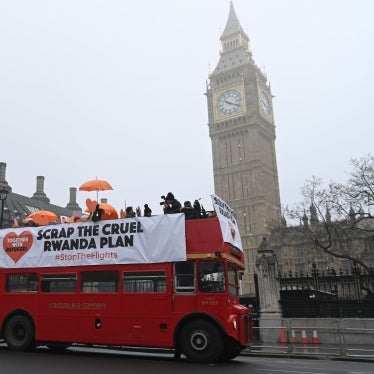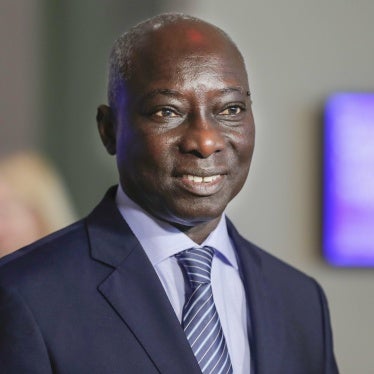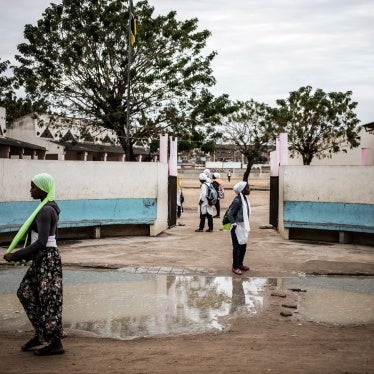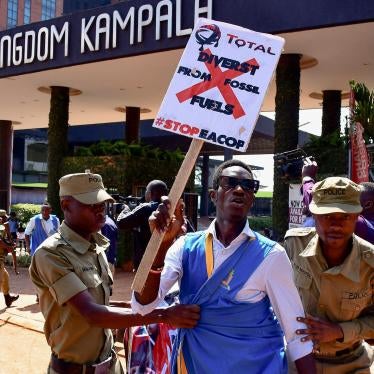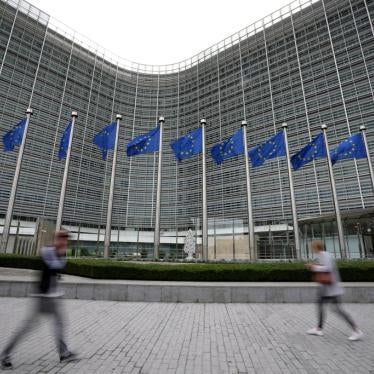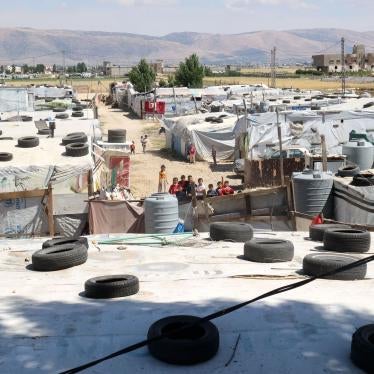Thank you, Mr. Chairman, and Senators, for the opportunity to testify at this hearing. I spent 25 days in Darfur, and among refugees from Darfur, in March and April and welcome the chance to tell you what I found there. I am an independent journalist and conducted this research on behalf of Human Rights Watch. The results of the research are available in the report, “Darfur Destroyed: Ethnic Cleansing by Government and Militia Forces in Western Sudan,” recently published.
The first, and most striking, thing I found in Darfur was a completely empty land—mile after mile of burned and abandoned villages that constitute irrefutable evidence of a scorched-earth policy the government says doesn’t exist. Hundreds of thousands of Masalit farmers, Sudanese of African descent, were living in the rural areas I visited little more than six months ago. Today there is, quite literally, no-one. Some have managed to flee to Chad; the others have been driven into government-controlled camps far from the border where they were, until very recently, at the complete mercy of the government and the Janjaweed—beyond the reach of any relief workers or independent observers.
The only civilians I encountered in Darfur were a handful of refugees who had crossed the border from Chad. They were venturing back to their village to dig up food stores they had buried in hope of preserving them in the event of attack by the army and the Janjaweed, militiamen drawn from some Arab tribes of Darfur and Chad. The refugees looked like walking dead – stick-thin, exhausted and ragged in a way they wouldn’t have been, despite their poverty, only a few months ago.
It is, of course, difficult to ascertain what exactly is happening in a place the size of Darfur, where the government denies access and all movement is impeded by the presence - and the fear - of the Janjaweed. I therefore decided to investigate a sample area: a 25-square mile block in which there were—until recently—14 villages inhabited by Masalit, one of the three tribes that form the backbone of the Sudan Liberation Army. (The other two are the Fur and the Zaghawa.) I found 11 of those 14 villages burned and three, in close proximity to them, abandoned for fear of burning. Mosques were burned; straw huts torched; food stores destroyed, in their totality. Cooking pots were smashed. Water pumps were not smashed because there were no pumps to smash in the first place. We are talking about people who have never had electricity, running water or, for the most part, schools or medical clinics; people whose best bet when they are seriously wounded is to go to Khartoum, more than 700 miles away, for treatment.
In these villages, everything that made life possible had been obliterated. Fields that had produced tomatoes, peppers, potatoes, cucumbers, beans and millet were dried up and strangled by weeds. Across the border in Chad, women went from home to home begging for food.
Everyone I talked to insisted there were no rebel positions anywhere near their villages. There certainly weren’t when I was there: we had to ride for several hours to reach any of the villages we visited. Some of the villages had had self-defense units—militias is far too grand a word—but this smattering of armed men proved incapable of defending either themselves or their villages. Many, many died.
Women of all ages had been raped - often in front of husbands and relatives – in the aftermaths of attacks; in, around and on the way to displaced camps; and while they searched for food, water and firewood.
I visited a number of other areas, less systematically, and found the same thing: no human life, and no way of sustaining life in the immediate future. The terrible humanitarian emergency we are seeing today, with 350,000 expected to die even if help is sent immediately, is the direct result of human rights abuses: scorched earth, denial of relief, denial of access—the same tactics the government of Sudan used most recently in its war to depopulate oil-producing areas of southern Sudan; the same tactics it used in the Nuba mountains; the same tactics it has always used.
The second thing that struck me in Darfur was the consistency of the victims’ stories. Estimates of the numbers of people killed in attacks by the government and Janjaweed varied. But descriptions of attacks were remarkably similar. It quickly became clear that the burning of Masalit villages has not been haphazard, but systematic. Whole areas have been cleared, one by one, by government and Janjaweed forces working together—sometimes coming out of garrison towns where they have separate barracks; sometimes advancing from joint positions more recently established in strategically located villages.
Typically, the regular army will surround a village with heavy weapons while Janjaweed on horse- or camel-back ride in, indiscriminately firing Kalashnikovs and sometimes rocket-propelled grenades. It has been said that men are being targeted – presumably in the belief that they could be members, or supporters, or even potential supporters, of the SLA. I do not believe that the attackers are targeting only men. What many witnesses described to me was how villagers, forewarned of attacks, send the women and children away on donkeys, leaving men behind to try to defend their homes.
Death tolls are chillingly high, especially when you consider how small most of these villages are. Our investigations uncovered large-scale killings in 14 incidents in the Masalit area between November 2003 and April 2004. In these 14 incidents, almost 800 civilians died. All 14 involved coordinated attacks by the army and Janjaweed, according to different eyewitnesses interviewed at different times and in different places.
These are not attacks, as they were in the past, by a handful of “Arab nomads” driven onto Masalit farming lands in search of water and grazing. They are attacks that often involve hundreds of men and are often coordinated across several fronts. They are carried out under the eyes of government soldiers, by men who wear the same uniform as the regular army, who carry the same light weapons as the army and who often enjoy the support of the Sudanese air force. Helicopter gun ships reconnoiter before and after attacks. Antonov bombers bomb in advance of attacks, especially in areas away from the international border where there are no independent witnesses. This is not happenstance. It is not coincidence. It is coordination.
Let me give you an example that is nothing out of the ordinary. The village of Tullus, several days’ walking away from the border with Chad, was attacked in February this year. Some of the attackers came from Mornei—a town of a few thousand inhabitants that today hosts tens of thousands of displaced—and a few inhabitants of Mornei rode out to warn neighboring villages. Some families left Tullus immediately. When Antonovs started bombing, women and children who had stayed behind were put on donkeys and sent to nearby hills. Then army Land Cruisers surrounded the village and Janjweed went in, killing at least 23 people and burning everything. All it takes in these mud-and-straw villages is a box of matches.
After the attack, soldiers and Janjaweed continued on to the hills where the women and children were hiding and began killing again. I could not get a precise figure for the dead—the field of vision of the fugitives here was often confined to the tree or the rock behind which they were hiding—but I am confident that at least 15 people were killed including seven women and six children.
On a hillside in Chad, where a three-month-old refugee baby had just died for reasons that will never be known, I met a 12-year-old survivor of Tullus—a boy called Hussein Dafa’allah. He ran from Tullus with his mother and hid behind a tree with three other children. The youngest of the three, a girl called Fatima, was only seven years old. Hussein said a group of uniformed men approached him as he hid and sat down beside him. These men were not behaving as if they feared attack. Their behavior surely suggests there were no rebels here, nothing that could be considered a military target. The men taunted Hussein, calling him a “Tora Bora”—a rebel, in Darfur-speak. Hussein told me: “There are no Tora Bora in Tullus. It’s a village.”
One of the men who cornered Hussein was apparently unarmed—a detail that suggests he was not a member of the Janjaweed. He ordered his companions to fire at the children behind the trees and Hussein was hit three times—in the face, a leg and an arm. The three other children were also hit, but no-one could tell me what became of them. When Hussein’s father arrived after the attackers left, he strapped his son onto a donkey and took him across Dar Masalit—the Masalit “homeland”—to Chad.
This was not the only instance I discovered of displaced Masalit being hunted down and killed. On August 27th last year, Antonovs bombed the town of Habila six times in one day. Twenty-six civilians were killed, including many women and children. Habila not only had a police station; it had an army post. The only explanation the people of Habila can find for the attack is that the town was packed with people displaced from neighboring villages. It wasn’t enough to destroy the villages, they said; they believed the government’s intention was to destroy the populations too.
Six months after this, on March 5th this year, 137 African men were executed in two separate but simultaneous operations in Wadi Saleh, due east of Dar Masalit. Most belonged to the Fur tribe. A neighbor of the sole survivor of one of the massacres told me that people in Wadi Saleh woke up on the morning of March 5th to find a large area surrounded by government and Janjaweed forces. These government forces entered villages within the cordon they had set up, apparently meeting no resistance, and asked men which villages they came from. More than 200 men whose villages had been burned and who were displaced were taken to police stations. In early evening, they were taken by army trucks to valleys where they were made to kneel and bend their heads before being killed with a bullet in the back of the neck.
Thus does the government’s scorched-earth policy set in motion a new cycle of atrocities. Today’s displaced are tomorrow’s rebels, or so the government fears.
For the past two decades, successive Sudanese governments have armed and supported militias recruited among groups of Arab descent in Darfur and Chad. But under the present government, what was essentially an economic conflict between African farmers and Arab pastoralists has evolved into an ethnic war with racial overtones between Muslims of African extraction and an Arab-centric Islamist government and its proxies. When the SLA took up arms 17 months ago, the government began fighting alongside its proxies.
The exact nature of the linkage and the chain of command between government forces and the Janjaweed is impossible to determine given the restrictions on access to government-controlled areas of Darfur and the government’s denial of any connection to a group it describes only as a “militia”. But there is no doubt in the minds of the African farmers who have survived attacks on their villages, farms and families that there is an organic, organizational link now between the army and the Janjaweed.
When I asked why they say this, two different people—one a village headman, the other an SLA commander—responded with exactly the same words: “They come together, they fight together and they leave together.” The army draws much of its soldiery from Darfurians of African origin, and the Masalit are in no doubt that the government trusts the Janjaweed far more than it trusts the army to fight in Darfur.
In recent years, thousands of Janjaweed have been organized into liwa, or brigades. These brigades are the same size as regular Sudanese army brigades and are headed by “generals” who wear the same stripes as generals in the regular army. Rebel leaders say they have identified six Janjaweed brigades—among them the Liwa al-Jammous, or Buffalo Brigade, and the Liwa al-Nasr, or Victory Brigade. These two brigades are headed respectively by Musa Hillal of the Um Jalloul tribe and Abdul Rahim Ahmad Mohammed, known universally as Shukurtallah, of the Mahariya tribe. Musa Hillal has enjoyed close relations with many senior government officials, prime among them a governor of North Darfur state, and is a frequent visitor to Khartoum. The Masalit say that Shukurtallah served in the army in Geneina and in Juba before being sentenced to 10 years’ imprisonment for killing Masalit civilians. But he was released from jail before completing his sentence, they say, and emerged as the leader of the Janjaweed in West Darfur state. Soldier to Janjaweed, via a murder conviction, in one easy step.
Top Janjaweed leaders all have one, or even two, homes in government garrison towns and have often been seen traveling in army cars. Several Masalit informants claimed that in 1999 government forces were seen training Janjaweed in El-Daien, 60 miles from Darfur’s southern border with Bahr el-Ghazal, alongside established government-backed militias like the “Peace Army”, a militia that operated in the Bentiu area, and the muraheleen, tribal militias from southern Darfur and southern Kordofan that in 1989 were incorporated into government militias controlled by the army, and used in the war in southern Sudan against Dinka and other southern peoples.
At the end of August 2003, Janjaweed took over from police and army in manning checkpoints in much of Dar Masalit. This could not have happened, nor be continuing, without the full agreement and compliance of the government.
In Geneina, capital of West Darfur state, Janjaweed are said to have a headquarters in the Medina al-Hujjuj, the old customs yard. Many Masalit reported seeing government helicopters and cars delivering weapons to Janjaweed positions. Others claimed knowledge of government payments to Janjaweed. A farmer from Gozbeddine, a village near Habila, said that in August 2003, as mass burnings became routine in Dar Masalit, local government officials promised all Arabs who came forward, with a horse or a camel, a gun and a monthly salary of 300,000 Sudanese pounds - U.S. $ 116, the equivalent of the per capita gross domestic production. This figure was repeatedly cited to me as a typical Janjaweed salary.
The Gozbeddine farmer said Janjaweed were recruited in Habila in an office that flew the Sudanese flag. “The Arabs weren’t organized before,” he said. “It was only groups of 30 or 40 attacking civilians for their cows.”
A government role in recruiting Janjaweed—and by extension, presumably, in paying them too—is confirmed by a document obtained by Human Rights Watch in which the state governor of South Darfur ordered commissioners to recruit “300 horsemen for Khartoum”. The letter, dated November 22, 2003, is from the office of the governor and is addressed to two commissioners in South Darfur state—one in Nyala, the state capital, and the other in Kas, one of the largest towns in South Darfur. The letter lists promised donations and projects which would benefit the Janjaweed community. These include the vaccination of camels and horses—the Janjaweed’s method of transport.
Government support for the Janjaweed is not limited to sins of commission; there are also sins of omission. The Janjaweed enjoy complete immunity in Darfur and roam around armed even though Sudan’s penal code posits 10 to 20 years’ imprisonment for carrying illegal weapons and ethnic Africans are regularly searched, apprehended, and imprisoned. Former members of the government’s security forces report receiving specific instructions not to interfere in any actions or operations by the Janjaweed.
Nureddine Abdul Ismael Abaker, a Masalit policeman from Misterei in West Darfur, received orders from the local army boss not to interfere with the Janjaweed. In his words: “To let them do whatever they wanted.” He resigned from the police force in 2003 because, he said, “the government took the Arab tribes and allowed them to be the law, over everyone else”. Policemen in Geneina said they too were ordered not to take action of any kind against Janjaweed and not to lodge any complaints against them. “Not to interfere with them in any way,” they said.
There is no doubt that the Janjaweed feel themselves empowered. Time and again, Masalit civilians said Janjaweed tell them “We are the government!” when challenged about their behavior. A 32-year-old farmer burned out of a village near Geneina quoted a Janjaweed leader in Geneina as telling residents of the town: “This place is for Arabs, not Africans. If you have a problem, don’t go to the police. Come to the Janjaweed. If we say you have to pay compensation, you pay. The Janjaweed is the government. The Janjaweed is Omar Bashir,” referring to Omar El Bashir, president of Sudan.
The Sudanese government’s extensive use of Janjaweed to fight the rebel movements—the SLA and the Justice and Equality Movement (JEM)—started after the rebels attacked the town and military base of El Fashir, capital of North Darfur state, in April 2003. The attack destroyed several Sudanese air force planes on the ground and shocked the Sudanese government, which was convinced that the rebels were aided from abroad. (An air force colonel captured by the rebels even gave an interview on Al Jazeera which was broadcast to the Arab world.) The Janjaweed, who were already inimical for economic reasons to the tribes from which rebels were recruited, already owned camels and horses, the best means of transportation in vast untarmacked Darfur. They already had guns, but the government provided more—along with training, communications equipment, and other war materiel.
The strategy is the same as used in the twenty-one years of war in southern Sudan and the Nuba Mountains: 1) finding an ethnic militia with existing rivalries with the targeted group (the ethnic group related to the rebels); 2) arming and supporting that militia, and giving it impunity for any crimes; 3) encouraging and helping it to attack the civilians of the targeted group, with scorched earth tactics often backed up by government ground troops and air power; 4) killing, raping, abducting, or forcibly displacing the targeted group and destroying its economy; and 5) denying humanitarian access to needy civilians. This pattern of attack has been used, again and again, in southern Sudan.
The strategy is still used in the south, despite an 18-month ceasefire there - in the Shilluk area, in the Upper Nile region of southern Sudan, in March 2004. There a southern government militia attacked and burned villages, forcibly displacing more than 100,000 civilians. The reason was that the military leader of the Shilluk changed loyalties (again) from the government to the SPLA—which is permissible under the current peace agreement in the south. Although he went to the SPLA, the government clearly did not want him to take with him the Shilluk land which is near oilfields in eastern Upper Nile.
Update
Even after having fled their homes, the vast majority of the more than one million displaced Darfurians are today utterly unprotected from violent abuse - unless they are among the 110,000 who have made the long journey to Chad, somehow evading Janjaweed “patrols” that attempt to interdict their escape. Originally cattle nomads, the Janjaweed continue to attack, rape, and steal from the displaced in the camps in Darfur. They have grown rich on the cattle they rustle, leaving their victims desperately poor.
The humanitarian crisis we are seeing today is the direct result of the forced displacement and violence directed at hundreds and hundreds of farming communities in North, West, and South Darfur. The displaced people are mostly farmers who have missed the May-June planting season because they were burned out of their homes and farms. Their seeds were burned or looted, and they still have no access to their land. As a result, U.S. AID has estimated that there are two million war-affected people in Darfur in need of emergency assistance—the displaced, those they are living with, and those who usually buy their produce.
Unless the Janjaweed militias are disarmed, disbanded and withdrawn from the areas they occupy, and from which they prey on displaced communities, there will be no possibility for civilians to return voluntarily and in safety to their homes and plant next year’s harvest. As it is, emergency relief is needed for at least sixteen months to save two million people from this entirely man-made famine.
Some local authorities are reportedly trying to force displaced to return to their villages to present a picture of “normalcy” to the international community, but by now the spotlight on Darfur is probably too bright for such deception to succeed. It is disturbing that there are still officials who attempt such maneuvers, however, as it does not bode well for government transparency and cooperation in southern Sudan.
The first rains have already come to Darfur. Soon the dirt tracks that serve as roads will be impassable, making it difficult if not impossible to move relief supplies overland. Mosquitoes and malaria will aggravate the health problems that are already killing in the displaced camps; measles has already started to carry away the small ones; cholera and other water-borne diseases pose real death threats to all during the rainy season. At one camp outside Nyala, deaths have been running at between 8-14 a day—most of them children. The camp has a population of 28,000 - and in the last three months has sprouted five cemeteries.
There are many reports of fighting and attacks on civilians, all of which violate a ceasefire agreement signed by the government and two rebel groups in Chad on April 8 2004. On May 22, fifty-six people were reportedly killed in a Janjaweed attack on a village in South Darfur—most of them just outside their huts. That was just part of a campaign to assert, or restore, government presence in areas south and east of Nyala, the capital of South Darfur, prior to the arrival of African Union ceasefire monitors.
Recent reports indicate that groups of Arab origin are moving into some of the lands bordering Chad that have been “ethnically cleansed” and are now under government and Janjaweed control. This trend paves the way for continued ethnic turmoil and threatens regional stability. Chad has even complained of Sudanese bombing on its soil in support of Janjaweed pursuing Sudanese refugees into Chad. While the Sudanese government trusts Chad’s President Idriss Deby, whom it helped seize power in Chad in 1990, many Chadians of Zaghawa ethnicity are literally up in arms in Darfur, to defend their fellow Zaghawa.
Rebel Abuses
The SLA began armed operations in February 2003 to protect African communities against a 20-year campaign by government-backed militias. Neither the SLA nor the JEM, the two rebel groups in western Sudan, was involved in the southern conflict; neither was a party to the north-south peace agreement.
Although the SLA won support by attacking government and military targets—with remarkable success initially—there is new evidence that even these targeted attacks took heavy civilian casualties. Recently received testimony indicates that the attack on El Fashir in April 2003, although apparently directed at military objectives, resulted in the deaths of numerous civilians as well as military personnel. The JEM has been accused by Amnesty International of incidents of torture of suspected informants, including using pepper in the eyes. Both groups have been accused of using child soldiers.
The SLA took sixteen humanitarian aid workers captive in June, of whom three were expatriates and thirteen Sudanese. This is a violation of international humanitarian law as the sixteen, who worked for various agencies in Darfur, were not military. They were released unharmed after three days.
Government officials and Arab groups in Darfur accuse the SLA and JEM of targeting civilians and destroying their villages, and have provided a list of ceasefire violations and attacks on villages to Human Rights Watch. We are eager to investigate these cases inside Darfur, but so far have not received a visa from the government. We have not found witnesses to these abuses in the Chad refugee camps, but that does not mean the abuses have not taken place. Only a fraction of the displaced has been able to reach Chad for refuge.
Recently the director of Human Rights Watch, Kenneth Roth, and a Sudan researcher, Leslie Lefkow, met with representatives of the rebel groups and presented them with a list of alleged abuses. The rebel denied the allegations but we expect to have a more detailed response from them. Because we have not had access to the government-held areas of Darfur, however, we have not been able to substantiate the government and other allegations.
In 25 days with SLA forces in Dar Masalit, I found a marked absence of many of the abuses that have sullied the SPLA’s record in southern Sudan. There was no evidence either of the use of child soldiers—the youngest rebel I encountered was 19—or of forced recruitment. The Masalit commander, Khamis Abdullah Abaker, admitted that neither was needed given the number of displaced adults offering themselves to the SLA as combatants. My observation was that the soldiers I encountered, and to whom I spoke, were farmers burned out of their homes, with a smattering of professionals, former government soldiers, and members of the police force who joined the SLA after their villages were attacked by the government they served.
Masalit civilians insisted that SLA positions were many miles away from their villages—one reason, they said, for the ease with which they had been displaced.
The U.S. Role
The U.S. has rightly taken the lead in the international community to insist that the Darfur crisis be addressed at the same time as the Naivasha peace accord is finalized, ending the twenty-one year war between the Sudanese government and the SPLA/M. The U.S. has contributed to the emergency relief fund and for other needs, and has encouraged its allies to act together diplomatically at the Security Council and elsewhere to stop the slaughter in Darfur. The U.S. has correctly identified this as “ethnic cleansing.” It has reiterated that its policy is to reverse the effects of this ethnic cleansing and enable the displaced to return home. It has stated that human rights abuses are causing the humanitarian emergency. The director of U.S. AID has said that the government must provide full humanitarian access to Darfur if up to a million people are not to die.
The U.S. should continue to remain fully engaged and to give the Darfur emergency top priority. The fighting and human rights abuses have not yet stopped, despite the ceasefire agreement. The African Union was asked by the parties to set up a ceasefire monitoring commission, and some of the logistical personnel for this team of approximately one hundred persons have arrived in Darfur, also with U.S. assistance. But the ceasefire monitors are not yet deployed.
Several additional actions are urgently needed, in which the U.S. must take the lead:
- A Chapter VII resolution at the U.N. Security Council whereby, if no effective measures have been taken by the Sudanese government to “neutralize” the Janjaweed within a specified time period, the Council will take further measures, including through the imposition of targeted sanctions and other measures, to:
- end and reverse “ethnic cleansing” in Darfur,
- ensure the protection of civilians at risk,
- create an environment conducive to the voluntary return in safety and dignity of all refugees and displaced persons,
- and provide for the effective and unrestricted delivery of humanitarian assistance.
- A U.N. human rights monitoring team for Sudan.
- A U.N. accountability mechanism for past crimes against humanity and other grave abuses in Sudan.
On May 25, the Security Council issued a Presidential Statement on Darfur which contained strong condemnation of abuses, and called on the Sudanese government to live up to its ceasefire commitment to “neutralize,” disarm, and disband the militias. On June 10 the G-8 group called “on the Sudanese government to disarm immediately the ‘Janjaweed’ and other armed groups which are responsible for massive human rights violations in Darfur”.
But the Sudanese government remains even more stubborn with regard to human rights, and investigation and prosecution of alleged abusers, than it does about relief access. No one, either military or Janjaweed, has been detained or prosecuted for the crimes against humanity or ethnic cleansing in Darfur. Only a handful has ever been prosecuted for individual cases of rape, murder, and looting. They have certainly not been disarmed.
Human Rights Monitoring
The U.S. should insist on one final ingredient for the Naivasha peace agreement, one which is vital for Darfur: that the peace agreement include a vigorous U.N. human rights monitoring team throughout Sudan, to periodically and publicly report on respect for human rights.
The parties to the north-south peace agreement already have agreed in writing to abide by human rights principles. The peace agreement, however, lacks any mechanism for monitoring human rights performance. There are to be elections in three years throughout Sudan, at the local, state, regional, and national levels. Monitoring is necessary in the period leading up to the elections to ensure a level playing field for all parties—especially the aggrieved citizens of Darfur.
It is not too late to insist that this monitoring be inserted into the peace accords. Implementation remains to be negotiated. The U.S. Congress should insist upon a U.N. human rights monitoring component to implement the human rights principles to which the parties have already agreed.
Human Rights Accountability
Similarly, the Naivasha peace agreement does not contain any provision for accountability for past abuses in the twenty-one year civil war in which more than two million died and four million were made homeless, most of them southerners. We agree with the call of the U.S. Congress in its concurrent resolution of May 17 urging the President to direct the U.S. ambassador to the U.N. to seek an official U.N. investigation into crimes against humanity in Darfur—but what about crimes against humanity committed in southern Sudan, the Nuba Mountains, and elsewhere during the long civil war? Should not Sudanese officials and others most responsible for these grave abuses also be investigated, and made answerable for their crimes?
It is sad to note that, even in the south, where a ceasefire has been in effect since October 2002, the Sudanese government continues to use its ethnic militias (in this case Nuer militias under the command of Gabriel Tanguinya) to conduct scorched earth campaigns in the Shilluk land, north of Malakal. Although the U.S.-sponsored Civilian Protection Monitoring Team (CPMT) reported that more than 100,000 Shilluk have been forcibly displaced, and their homes burned, the guilty remain at large, enjoying complete impunity for their crimes. They and the relevant Sudanese government officials must be accountable - not only the ethnic militias in Darfur.
We urge members of Congress to insist that accountability be an integral part of the Naivasha peace agreement - not only for Darfur, but for all of Sudan.
The U.S. and future response
The political lead must be taken by the U.S. and the Security Council to end abuses and reverse ethnic cleansing in Darfur, which is the stated policy of the United States.
It is time for the Security Council to pass a resolution under Chapter VII to prepare the way to take measures to relieve the massive human rights abuses and the famine even without the consent of the Sudanese government. There is no time to waste.
